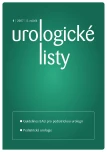Varicocele - what is the best timing and method of treatment?
Authors:
R. Kočvara
Authors‘ workplace:
1. LF UK a VFN, Praha
; Urologická klinika
Published in:
Urol List 2007; 5(1): 26-29
Overview
Varicocele usually occurs in early puberty. Physical examination must determine the level of varicocele and assess the size of testicles. The finding is confirmed by verification of venose reflux and further assessment of testicle size during sonography. Only 20% of adolescents suffering from varicocele will have fertility problems - therefore its treatment is usually conservative. For early operation only those are indicated suffering from smaller testicle, functionally solitaire testicle, bilateral palpable varicocele and older adolescents with pathologic spermiograms.
In operated patients, larger sizes of testicle and better semen parameters have been described.
Lymphatics sparing operation is recommended using microsurgical techniques (open using a micsroscope or by means of laparoscopy) to prevent occurrence of hydrocele, intra-testicular oedema (testicle hypertrophy) and to improve testicle function.
Key words:
varicocele, adolescent varicocele, infertility, microsurgery, laparoscopy
Sources
1. Cayan S, Kadioglu TC, Tefekli A et al. Comparison of results and complications of high ligation surgery and microsurgical high varicocelectomy in the treatment of varicocele. Urology 2000; 55 : 750-754.
2. Cayan S, Akbay E, Bozlu M et al. The effect of varicocele repair on testicular volume in children and adolescents with varicocele. J Urol 2002; 168 : 731-734.
3. Cayan S, Acar D, Ulger S, Akbay W. Adolescent varicocele repair: long-term results and comparison of surgical techniques according to optical magification use in 100 cases at a single university hospital. J Urol 2005; 174 : 2003-2007.
4. Chan PTK, Wright EJ, Goldstein M. Incidence and postoperative outcomes of accidental ligation of the testicular artery during microsurgical varicocelectomy. J Urol 2005; 178 : 482-484.
5. Gershbein AB, Horowitz M, Glassberg KI. The adolescent varicocele I: Left testicular hypertrophy following varicocelectomy. J Urol1999; 162 : 1447-1449.
6. Gorelick JE, Goldstein M. Loss of fertility in men with varicocele. Fertil Steril1993; 59 : 613-616.
7. Hassan JM, Adams MC, Pope JC et al. Hydrocele formation following laparoscopic Varicocelectomy. J Urol 2006; 175 : 1076-1079.
8. Hopps CV, Lemer ML, Schlegel PN et al. Intraoperative varicocele anatomy: a microscopic study of the inguinal versus subinguinal approach. J Urol 2003; 170 : 2366-2370.
9. Kass EJ, Belman AB. Reversal of testicular growth failure by varicocele ligation. J Urol 1987; 137 : 475-476.
10. Kass EJ, Marcol B. Results of varicocele surgery in adolescents: a comparison of techniques. J Urol 1992;148 : 694-696.
11. Kočvara R, Doležal J, Hampl R et al. Division of lymphatic vessels at varicocelectomy leads to testicular oedema and decline in testicular function according to the LH-RH analogue stimulation test. Eur Urol 2003; 43 : 430-435.
12. Kočvara R, Dvořáček J, Sedláček J et al. Lymphatic-sparing laparoscopic varicocelectomy: a microsurgical repair. J Urol 2005; 173 : 1751-1754.
13. Kočvara R, Doležal J, Dítě Z et al. Paediatric varicocele - indications for early surgical repair: a prospective study. J Pediatr Urol 2007; v tisku.
14. Kogan SJ. The pediatric varicocele. In: Gearhart JP, Rink RC, Mouriquand PDE (eds). Pediatric Urology. Philadelphia: W.B. Saunders Company 2001 : 763-774.
15. Laven JSE, Haans LCF, Mali WPTM et al. Effect of varicocele treatment in adolescents: a randomized study. Fertil Steril 1992; 58 : 756-762.
16. May M, Johannsen M, Beutner S et al. Laparoscopic surgery versus antegrade scrotal sclerotherapy: retrospective comparison of two different approaches for varicocele treatment. Eur Urol 2006; 49 : 384-387.
17. Mazzoni G, Minucci S, Gentile V. Recurrent varicocele: role of antegrade sclerotherapy as first choice treatment. Eur Urol 2002; 41 : 614-618.
18. Paduch DA, Niedzielski J. Repair versus observation in adolescent varicocele: A prospective study. J Urol 1997; 158 : 1128-1132.
19. Pinto KJ, Kroovand RL, Jarow JP. Varicocele related testicular atrophy and its predictive effect upon fertility. J Urol 1994; 152 : 788-790.
20. Riccabona M, Oswald J, Koen M et al. Optimizing the operative treatment of boys with varicocele: Sequential comparison of 4 techniques. J Urol 2003; 169(2): 666-668.
21. Schiff J, Kelly C, Goldstein M et al. Managing varicoceles in children: results with microsurgical varicocelectomy. BJU Int 2005; 95 : 399-402.
22. Schwentner C, Oswald J, Lunacek A et al. Optimizing the outcome of microsurgical subinguinalvaricocelectomy using Isosulfan Blue: a prospective randomized trial. J Urol 2006; 175 : 1049-1052.
23. Szabo R, Kessler R. Hydrocele following internal spermatic vein ligation: a retrospective study and review of the literature. J Urol 1984; 132 : 924-925.
24. Študent V, Záura F, Scheinar J et al. Testicle hemodynamics in patients after laparoscopic varicocelectomy evaluated using color Doppler sonography. Eur Urol 1998; 33 : 91.
25. Thon WF, Gall H, Danz B et al. Percutaneous sclerotherapy of idiopathic varicocele in childhood: a preliminary report. J Urol 1989; 141 : 913-915.
26. Zaupa P, Mayr J, Hoellwarth T. Antegrade scrotal sclerotherapy for treating primary varicocele in children. BJU Int 2006; 97 : 809-812.
Labels
Paediatric urologist UrologyArticle was published in
Urological Journal

2007 Issue 1
Most read in this issue
- Hypospadias - optimum methods of treatment
- Varicocele - what is the best timing and method of treatment?
- Sexual diferentiation disorders
- Obstructive uropathy in infancy
